Using SetSystemCursor it is possible to set a cursor to an image of much larger size than the standard cursor.
Here is a class I have for resizing the system cursors:
using System;
using System.Drawing;
using System.Reflection;
using System.Runtime.InteropServices;
namespace WindowsFormsApplication1
{
class SystemCursors
{
[DllImport("user32.dll")]
static extern bool SetSystemCursor(IntPtr hcur, uint id);
enum CursorShift
{
Centered,
LowerRight,
}
public static void SetSystemCursorsSize(int newSize)
{
ResizeCursor(System.Windows.Forms.Cursors.AppStarting, newSize, CursorShift.LowerRight);
ResizeCursor(System.Windows.Forms.Cursors.Arrow, newSize, CursorShift.LowerRight);
ResizeCursor(System.Windows.Forms.Cursors.Cross, newSize, CursorShift.Centered);
ResizeCursor(System.Windows.Forms.Cursors.Hand, newSize, CursorShift.LowerRight);
ResizeCursor(System.Windows.Forms.Cursors.Help, newSize, CursorShift.LowerRight);
ResizeCursor(System.Windows.Forms.Cursors.HSplit, newSize, CursorShift.Centered);
ResizeCursor(System.Windows.Forms.Cursors.IBeam, newSize, CursorShift.Centered);
ResizeCursor(System.Windows.Forms.Cursors.No, newSize, CursorShift.LowerRight);
ResizeCursor(System.Windows.Forms.Cursors.NoMove2D, newSize, CursorShift.LowerRight);
ResizeCursor(System.Windows.Forms.Cursors.NoMoveHoriz, newSize, CursorShift.LowerRight);
ResizeCursor(System.Windows.Forms.Cursors.NoMoveVert, newSize, CursorShift.LowerRight);
ResizeCursor(System.Windows.Forms.Cursors.PanEast, newSize, CursorShift.Centered);
ResizeCursor(System.Windows.Forms.Cursors.PanNE, newSize, CursorShift.Centered);
ResizeCursor(System.Windows.Forms.Cursors.PanNorth, newSize, CursorShift.Centered);
ResizeCursor(System.Windows.Forms.Cursors.PanNW, newSize, CursorShift.Centered);
ResizeCursor(System.Windows.Forms.Cursors.PanSE, newSize, CursorShift.Centered);
ResizeCursor(System.Windows.Forms.Cursors.PanSouth, newSize, CursorShift.Centered);
ResizeCursor(System.Windows.Forms.Cursors.PanSW, newSize, CursorShift.Centered);
ResizeCursor(System.Windows.Forms.Cursors.PanWest, newSize, CursorShift.Centered);
ResizeCursor(System.Windows.Forms.Cursors.SizeAll, newSize, CursorShift.Centered);
ResizeCursor(System.Windows.Forms.Cursors.SizeNESW, newSize, CursorShift.Centered);
ResizeCursor(System.Windows.Forms.Cursors.SizeNS, newSize, CursorShift.Centered);
ResizeCursor(System.Windows.Forms.Cursors.SizeNWSE, newSize, CursorShift.Centered);
ResizeCursor(System.Windows.Forms.Cursors.SizeWE, newSize, CursorShift.Centered);
ResizeCursor(System.Windows.Forms.Cursors.UpArrow, newSize, CursorShift.Centered);
ResizeCursor(System.Windows.Forms.Cursors.VSplit, newSize, CursorShift.Centered);
ResizeCursor(System.Windows.Forms.Cursors.WaitCursor, newSize, CursorShift.LowerRight);
}
private static void ResizeCursor(System.Windows.Forms.Cursor cursor,
int newSize, CursorShift cursorShift)
{
Bitmap cursorImage = GetSystemCursorBitmap(cursor);
cursorImage = ResizeCursorBitmap(cursorImage, new Size(newSize, newSize), cursorShift);
SetCursor(cursorImage, getResourceId(cursor));
}
public static Bitmap GetSystemCursorBitmap(System.Windows.Forms.Cursor cursor)
{
Bitmap bitmap = new Bitmap(
cursor.Size.Width, cursor.Size.Height,
System.Drawing.Imaging.PixelFormat.Format32bppArgb);
Graphics graphics = Graphics.FromImage(bitmap);
cursor.Draw(graphics,
new Rectangle(new Point(0, 0), cursor.Size));
bitmap = Crop(bitmap);
return bitmap;
}
private static Bitmap Crop(Bitmap bmp)
{
//code from http://stackoverflow.com/a/10392379/935052
int w = bmp.Width;
int h = bmp.Height;
Func<int, bool> allWhiteRow = row =>
{
for (int i = 0; i < w; ++i)
if (bmp.GetPixel(i, row).A != 0)
return false;
return true;
};
Func<int, bool> allWhiteColumn = col =>
{
for (int i = 0; i < h; ++i)
if (bmp.GetPixel(col, i).A != 0)
return false;
return true;
};
int topmost = 0;
for (int row = 0; row < h; ++row)
{
if (allWhiteRow(row))
topmost = row;
else break;
}
int bottommost = 0;
for (int row = h - 1; row >= 0; --row)
{
if (allWhiteRow(row))
bottommost = row;
else break;
}
int leftmost = 0, rightmost = 0;
for (int col = 0; col < w; ++col)
{
if (allWhiteColumn(col))
leftmost = col;
else
break;
}
for (int col = w - 1; col >= 0; --col)
{
if (allWhiteColumn(col))
rightmost = col;
else
break;
}
if (rightmost == 0) rightmost = w; // As reached left
if (bottommost == 0) bottommost = h; // As reached top.
int croppedWidth = rightmost - leftmost;
int croppedHeight = bottommost - topmost;
if (croppedWidth == 0) // No border on left or right
{
leftmost = 0;
croppedWidth = w;
}
if (croppedHeight == 0) // No border on top or bottom
{
topmost = 0;
croppedHeight = h;
}
try
{
var target = new Bitmap(croppedWidth, croppedHeight);
using (Graphics g = Graphics.FromImage(target))
{
g.DrawImage(bmp,
new RectangleF(0, 0, croppedWidth, croppedHeight),
new RectangleF(leftmost, topmost, croppedWidth, croppedHeight),
GraphicsUnit.Pixel);
}
return target;
}
catch (Exception ex)
{
throw new Exception(
string.Format("Values are topmost={0} btm={1} left={2} right={3} croppedWidth={4} croppedHeight={5}", topmost, bottommost, leftmost, rightmost, croppedWidth, croppedHeight),
ex);
}
}
private static Bitmap ResizeCursorBitmap(Bitmap bitmap, Size size, CursorShift cursorShift)
{
if (size.Width > 32)
{
//shifting must occur
Bitmap intermediateBitmap = new Bitmap(64, 64);
Graphics intermediateGraphics = Graphics.FromImage(intermediateBitmap);
if (cursorShift == CursorShift.LowerRight)
//place the mouse cursor in the lower right hand quadrant of the bitmap
intermediateGraphics.DrawImage(bitmap,
intermediateBitmap.Width / 2, intermediateBitmap.Height / 2);
else if (cursorShift == CursorShift.Centered)
intermediateGraphics.DrawImage(bitmap,
intermediateBitmap.Width / 2 - bitmap.Width / 2,
intermediateBitmap.Height / 2 - bitmap.Height / 2);
//now we have a shifted bitmap; use it to draw the resized cursor
//Bitmap finalBitmap = new Bitmap(intermediateBitmap, size); //normal quality
Bitmap finalBitmap = new Bitmap(size.Width, size.Height);
Graphics finalGraphics = Graphics.FromImage(finalBitmap);
finalGraphics.CompositingQuality = System.Drawing.Drawing2D.CompositingQuality.HighQuality;
finalGraphics.InterpolationMode = System.Drawing.Drawing2D.InterpolationMode.HighQualityBicubic;
finalGraphics.SmoothingMode = System.Drawing.Drawing2D.SmoothingMode.HighQuality;
finalGraphics.DrawImage(intermediateBitmap, 0, 0, finalBitmap.Width, finalBitmap.Height);
return finalBitmap;
}
else
{
Bitmap newBitmap = new Bitmap(bitmap, size);
return newBitmap;
}
}
private static uint getResourceId(System.Windows.Forms.Cursor cursor)
{
FieldInfo fi = typeof(System.Windows.Forms.Cursor).GetField(
"resourceId", BindingFlags.NonPublic | BindingFlags.Instance);
object obj = fi.GetValue(cursor);
return Convert.ToUInt32((int)obj);
}
private static void SetCursor(Bitmap bitmap, uint whichCursor)
{
IntPtr ptr = bitmap.GetHicon();
bool retval = SetSystemCursor(ptr, whichCursor);
}
}
}
It works by getting the current system cursor as provided in System.Windows.Forms.Cursors and making an image from it with Cursor.Draw. The image is then resized to the desired size. This requires shifting the cursor image, either to the lower right hand corner (like for arrow pointers) or centering the cursor image inside the larger image (like for Cross and IBeam).
You can use your own image for the cursor if desired, bypassing all the resizing code. Just supply the Bitmap to SetCursor.
Once the new cursor image is ready, the last piece of data needed is the ID of the cursor we are trying to replace. Each System.Windows.Forms.Cursor does contain this information, but in a private variable, so reflection is used to get the value. If you prefer to avoid reflection, you could build a table of these values instead. See MSDN SetSystemCursor for a list of values.
To use the class just call
SystemCursors.SetSystemCursorsSize(128);
